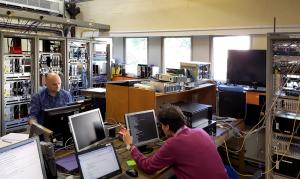Real-time collaboration delivers for fusion computing
A key computing system for ITER is now being trialled at the European tokamak JET, following collaboration between teams at the UK's Culham Centre for Fusion Energy (CCFE), the ITER Organization and the European Domestic Agency for ITER.
Adam Stephen, CODAS project manager at Culham, teamed up with his counterparts Bertrand Bauvir from ITER and Andre Neto from the European agency to integrate the ITER synchronous databus network on the live JET machine.
The synchronous databus network consists of a high performance software/hardware stack for interconnecting diagnostic and control systems on a tokamak, according to Adam. "The equivalent real-time data network system on JET is a core part of the plasma control system and has delivered ever-increasing functionality to the fusion scientists over the last decade." What was needed to further improve JET equipment was a real-time Ethernet feed of data to a new visualization service that would give physicists a better live view of key JET measurements.
Installing the ITER system was a chance to do that, while at the same time validating the network on an operational fusion experiment ahead of ITER's start-up in 2025.
Thanks to the intensive work and resourcefulness of the team, and the strong backing and support from each of the organizations, the equipment was installed in only three days, a success that was warmly welcomed by Andrew Hynes, CCFE's head of CODAS&IT, Anders Wallander, head of the ITER Control System Division, and Filippo Sartori, head of Instrumentation & Control at the European Domestic Agency.
The project has provided enhanced control room tools by integrating ITER software with state-of-the-art data visualization tools from the JET data analysis group. It has also paved the way for the future evolution of the JET real-time data network using up-to-date maintainable software and hardware. Importantly, the compatibility with ITER equipment further opens the possibility of integrating and testing future ITER systems on JET.


